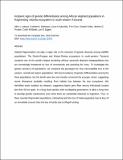| dc.description.abstract | Habitat fragmentation can play a major role in the reduction of genetic diversity among wildlife populations. The Ruaha-Rungwa and Katavi-Rukwa ecosystems in south-western Tanzania comprise one of the world's largest remaining African savannah elephant metapopulations but are increasingly threatened by loss of connectivity and poaching for ivory. To investigate the genetic structure of populations, we compared the genotypes for nine microsatellite loci in the western, central and eastern populations. We found evidence of genetic differentiation among the three populations, but the levels were low and mostly concerned the younger cohort, suggesting recent divergence probably resulting from habitat loss between the two ecosystems. We identified weak isolation by distance, suggesting higher gene flow among individuals located less than 50 km apart. In a long-lived species with overlapping generations, it takes a long time to develop genetic substructure even when there are substantial obstacles to migration. Thus, in these recently fragmented populations, inbreeding (and the loss of heterozygosity) may be less of an immediate concern than the loss of adults due to illegal hunting. | en_US |

